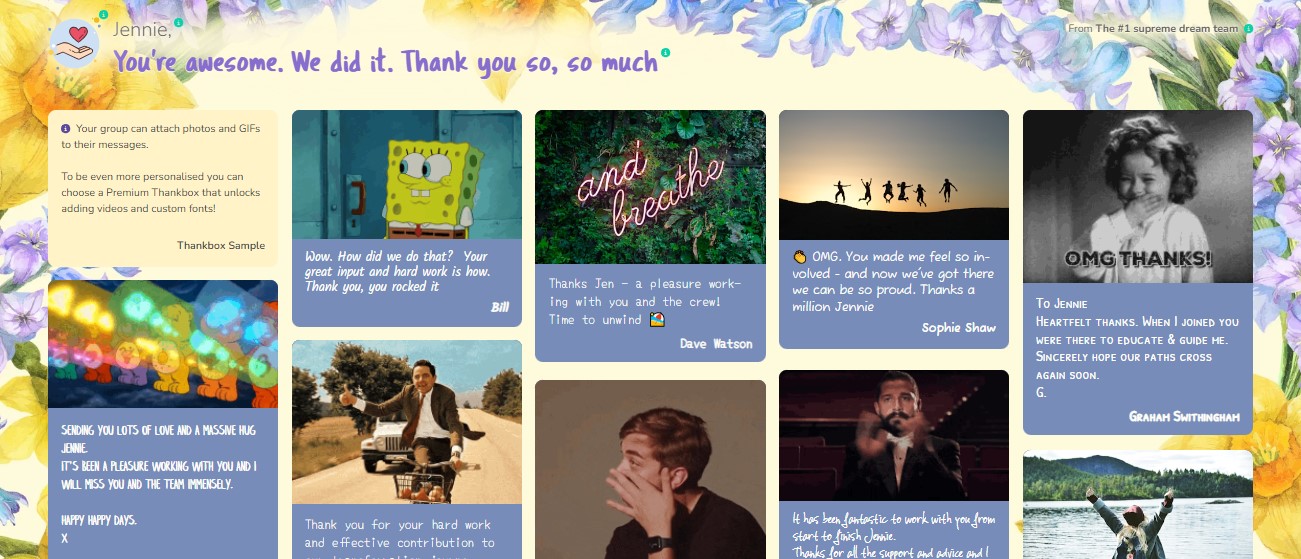Employee Performance: How to Measure, Evaluate & Improve for Success


Ever felt like managing a team is a bit like trying to keep all your tabs organised—only they have KPIs and occasional WiFi issues? We get it. One minute, everything’s running smoothly, and the next, you’re dealing with missed deadlines, mysterious ‘urgent’ meetings, and someone who’s somehow still on mute in a video call.
But here’s the deal: great employee performance is what keeps businesses running smoothly (and keeps managers from stress-eating biscuits in the breakroom). When employees are engaged, productive, and motivated, everything just works. Targets are hit, deadlines don’t feel like doomsday, and customers stay happy.
So, how do you make sure your team isn’t just working but thriving? That’s exactly what we’re diving into in this Thankbox guide. Grab a cuppa, and let’s break it down.
What is employee performance?
Let’s start with the basics—what even is employee performance? Simply put, it’s how well someone gets their job done. And we’re not just talking about smashing deadlines or showing up to Zoom meetings on time (though, let’s be honest, that’s impressive enough for some).
A high-performing employee ticks a few key boxes:
Delivers quality work without needing a reminder every five minutes.
Gets things done efficiently–no last-minute chaos.
Works well with others (read: doesn’t cause workplace drama).
Aligns with company goals, rather than just clocking in and out like a robot.
When employees perform well, businesses thrive, staff morale soars, and the dreaded “we need to have a chat about performance” meetings become a thing of the past.
Why is measuring employee performance important?
When you focus on employee performance, great things happen (no magic wand required). Here’s how it helps your organisation:
Spot skill gaps early – No more scrambling to fix problems at the last minute.
Keep everyone aligned – Make sure individual efforts contribute to the bigger picture.
Encourage growth – Recognise wins and provide opportunities for employees to develop.
Prioritising performance doesn’t just boost productivity—it creates a motivated, engaged team that’s ready to smash their goals. A win-win for everyone.
How do you measure employee performance?
Measuring employee performance isn’t about drowning in spreadsheets or holding never-ending meetings. It’s about understanding what’s working, what’s not, and how to help your team thrive. Here are five simple ways to gauge performance:
1. Quality of work
The standard of an employee’s work is a key indicator of performance. It’s not just about getting the job done—it’s about getting it done well. Are tasks completed to a high standard, or are they riddled with errors? Quality work shows attention to detail, care, and a commitment to doing things right the first time.
2. Efficiency & time management
Deadlines exist for a reason, and how employees handle them says a lot. Are they delivering work on time without unnecessary delays? Efficiency isn’t about rushing—it’s about smart time management, knowing when to ask for help, and avoiding the “panic mode” approach to projects. It also considers how well they use resources are to deliver maximum output with minimal waste.
3. Reliability & consistency
A superstar one day and missing in action the next? Not ideal. Great employees show up (physically or virtually), meet expectations, and don’t need constant hand-holding. If someone can work independently, maintains punctuality, and consistently delivers results that align with company values, it shows that they are engaged and committed.
4. Collaboration & attitude
Even the best solo performers can struggle if they can’t work well with others. Do they contribute to a positive team culture? Are they open to feedback and willing to support their colleagues? A workplace where people actually like working together is a game-changer.

5. Impact & contribution
At the end of the day, every role should add value. Whether it’s smashing sales targets, keeping customers happy, or making processes more efficient—how does an employee’s work contribute to the bigger picture? The best employees don’t just ‘do the job’—they help move the business forward.
Pro tip: Performance measurement isn’t just about identifying weak spots—it’s also about recognising what’s going right. Celebrate wins, give feedback that actually helps, and make sure employees feel valued. Happy teams = high-performing teams.
Boosting employee performance starts with feeling valued. A Thankbox makes it easy to recognise hard work, celebrate wins, and keep motivation high. A few kind words from colleagues can go a long way—so why not spread the positivity today? Create a Thankbox and watch your team thrive!
How to evaluate employee performance
Measuring performance is one thing—actually evaluating it? That’s where the magic happens. Evaluation shouldn’t involve micromanaging or surprise performance reviews that make employees break into a cold sweat. It should be fair, useful feedback that helps everyone grow.

Here’s how to do it right:
1. 360-degree feedback
If you want a well-rounded view of an employee’s performance, ask the people who work directly with them. Gather feedback from managers, peers, and even direct reports. With this approach you can identify consistent patterns and get a well-rounded perspective on the employee’s strengths and areas for improvement. It’s like a performance review, but without the awkward one-on-one where people just nod and agree.
2. Goal-based evaluation
Forget vague performance reviews—collaborate with employees to set clear, measurable goals instead. If employees know exactly what success looks like, they’re more likely to achieve it. Whether it's hitting targets, completing projects, or levelling up their skills, tracking progress keeps everyone focused.
3. Performance rating scales
Sometimes, a simple rating system (think: 1 to 5 or “Smashing it” to “Needs a boost”) does the job. You can use it to rank performance across specific criteria, such as work quality, punctuality, or project completion. It gives a quick snapshot of strengths and areas for improvement—just make sure it’s meaningful and not just ticking boxes for the sake of it.
4. Self-evaluation
Asking employees to reflect on their own performance can be eye-opening (for them and you). Do they see their strengths? Are they aware of their own growth areas? Comparing self-reviews with manager feedback can lead to some great development conversations.
5. SWOT analysis
Strengths, Weaknesses (or let’s call them "Improvement Areas"), Opportunities, and Threats—this classic business tool works wonders for performance evaluations too. It helps identify what’s going well, where support is needed, and how employees can grow in their roles.
8 ways to improve employee performance
So, you’ve measured and evaluated employee performance—now what? Time to actually do something about it! Whether your team is already flying high or needs a little boost, these eight strategies will help everyone work smarter, feel valued, and stay motivated.
1. Figure out what is holding them back
If performance is slipping, there’s usually a reason (and no, it’s not just because the coffee machine is broken). Have open chats with employees to understand what’s getting in their way—lack of training and resources, unclear expectations, or maybe just too many meetings that could’ve been an email. Solve the root cause, and you’ll see real improvements.
Boosting employee performance starts with feeling valued. A Thankbox makes it easy to recognise hard work, celebrate wins, and keep motivation high. A few kind words from colleagues can go a long way—so why not spread the positivity today? Create a Thankbox and watch your team thrive!
2. Provide constructive and consistent feedback
Nobody improves with vague feedback like "Just do better" (helpful, right?). Be specific, constructive, and regular with your feedback. Employees need to know what’s working and what’s not—without feeling like they’re being ambushed in their annual review.
3. Invest in learning and development
Skills don’t upgrade themselves. Whether it’s training, mentorship, or giving employees time to develop professionally, investing in growth is a win-win. Employees feel valued, and you get a more skilled, engaged team—what’s not to love?
4. Set measurable and realistic goals
Unclear goals are about as useful as a map without street names. Employees need clear, achievable targets that challenge them without leading to burnout. Plus, regular check-ins help keep things on track (and prevent any “Wait, I was supposed to do that?” moments).
5. Create a positive workplace culture
Happy employees = productive employees. A workplace where people feel supported, included, and heard makes a huge difference. Encourage collaboration, keep communication open, and maybe—just maybe—make team meetings a little more fun (yes, it’s possible). Just take a look at our guide on 20 Fun Office Games to Lighten the Mood.

6. Recognise and celebrate achievements (big and small)
A simple “thank you” or shoutout can go a long way. People thrive when they feel appreciated, so make recognition part of your culture. And hey, if you want to go the extra mile, a Thankbox is always a winner. It’s a fantastic way of encouraging peer-to-peer recognition and dishing out rewards for a job well done.

With Thankbox, you can send online group greeting cards bursting with personalised messages, hilarious GIFs, and even memorable photos and videos straight from your desk. Looking to make it extra special? We’ve got digital gift cards and even wine and flower delivery!
7. Take a personalised approach
Not every employee is motivated the same way. Some thrive on new challenges, while others need extra support. A one-size-fits-all approach doesn’t work—take the time to understand what drives each person and tailor your support accordingly.
8. Address issues before they escalate
If someone is struggling, don’t wait for things to get worse. Have honest, solution-focused conversations early on. Offer guidance, set clear expectations, and provide the right resources. Tackling issues proactively keeps the whole team on track.

Wrapping up
Employee performance isn’t about endless meetings, intimidating reviews, or keeping tabs on how long someone spends by the coffee machine. It’s about setting people up for success, giving them the tools and support they need, and recognising their efforts along the way.
When employees feel valued, they want to do their best work. So keep feedback meaningful, celebrate wins—big and small—and create a workplace where people actually enjoy showing up (even if it’s just logging in from their sofa).
And speaking of celebrating wins, nothing says “you’re appreciated” quite like a Thankbox full of kind words from colleagues. Whether it’s a job well done, a workiversary, or just because—showing gratitude keeps morale high and teams thriving.
So, ready to boost performance, motivation, and a few smiles along the way? Create a Thankbox today and show your employees their efforts matter!
Images: Cover | Happy people looking at a laptop | Signing a document | Employees playing foosball in office | Man and woman using a laptop





